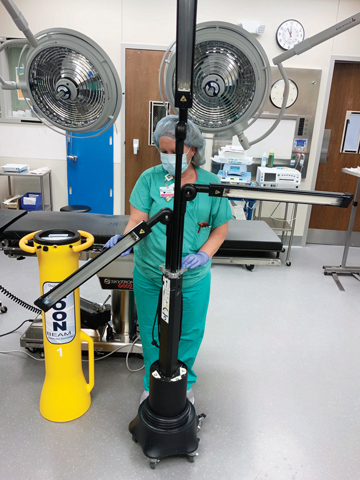An increasing number of disinfecting robots have been rolling through the hallways at Texas Health Harris Methodist Hospital Fort Worth. They’re being used in various areas of the facility, including the ORs. Not surprisingly, after a year of the pandemic, they’re in high demand.
Prinu Gabriel, MS, SM(ASCP)CM, CIC, the facility’s manager of infection prevention, says two of the machines first arrived around six years ago, and their number has grown since that time. Most employ UVC technology that operates at the favorably germicidal wavelength of between 240 and 280 nanometers.
The robots are used as regularly as possible in the hospital’s 30-plus OR suites. “It’s highly impossible to target all of the rooms in one day, so we do them in a cycle,” says Ms. Gabriel. “At the end of the day, the expectation is we at least utilize them in four ORs. Then the next day we use them in the next four, and so on.”
As at many facilities, the UVC robots are an adjunct to manual cleaning, providing peace-of-mind and reassurance that pathogens that vigorously wiping staffers miss will be eliminated. “UVC reaches surfaces that the manual clean may not reach,” says Ms. Gabriel. It takes the UVC robots about 30 minutes to disinfect the hospital’s larger OR suites, but Ms. Gabriel says they don’t need to be repositioned once they’re in the room. “You bring the robot to the room, set it in one spot and it measures the room,” she says. “The timing for each OR is different based upon the size of the room.”
However, just because the robots are in demand doesn’t mean a staffer can grab one whenever they’d like. For one, even though they’re on wheels, they’re not easy to move. In addition, they’re costly and must be handled with care. “Because of the expense of the machines, our environmental services department has dedicated supervisors and technicians who are trained to use them,” says Ms. Gabriel.
Environmental services (EVS) staff leverage electronic communications to ensure the machines are used efficiently. “Once the terminal cleaning is done on a room, an EVS employee will tag in their system that the room is ready to go, and somebody else brings in the robot,” says Ms. Gabriel.
Once the machine is turned on, humans can’t enter the room because they can be harmed by UVC light. As the machine performs its cycle, EVS staff time when the cycle will be complete so they can retrieve the machine when it’s done.
The electronic documentation EVS staff use is useful for monitoring compliance and, perhaps more importantly, for retrospective analysis. “If we get a serious infection, we can go back and see which room it was in, and whether the room was treated with UVC disinfection.” says Ms. Gabriel.
Overall, the hospital is pleased with the performance of the robots, and even partnered with the health department on a study about their effectiveness. “We swabbed rooms after they had been manually cleaned, and also swabbed rooms after a manual clean followed by UV disinfection,” says Ms. Gabriel. “We were able to isolate C. diff spores after the manual clean, but could not find it anywhere in the rooms where we used UV disinfection.”
Ms. Gabriel’s hospital hasn’t employed UVC beyond its fleet of robots, and views it primarily as an adjunct to surface disinfection technology. She is confident that frequent air exchanges in the ORs handle airborne pathogens effectively — and as a bonus, aerosolized particles that may still remain in a room will be eradicated by the robots as its rays bounce from one surface to another.
.svg?sfvrsn=be606e78_3)

.svg?sfvrsn=56b2f850_5)